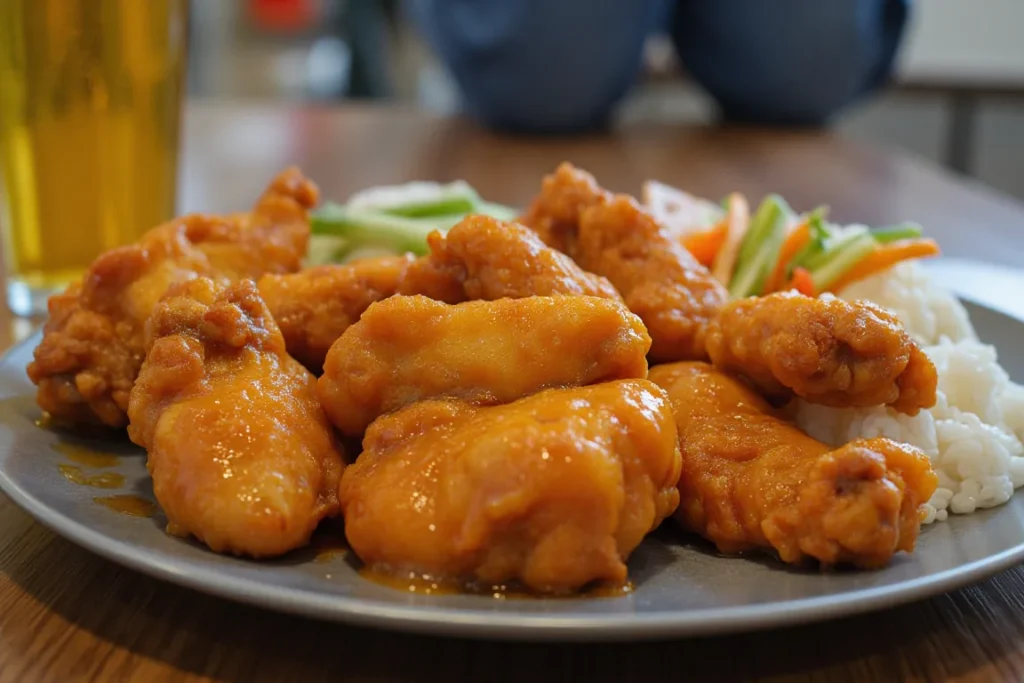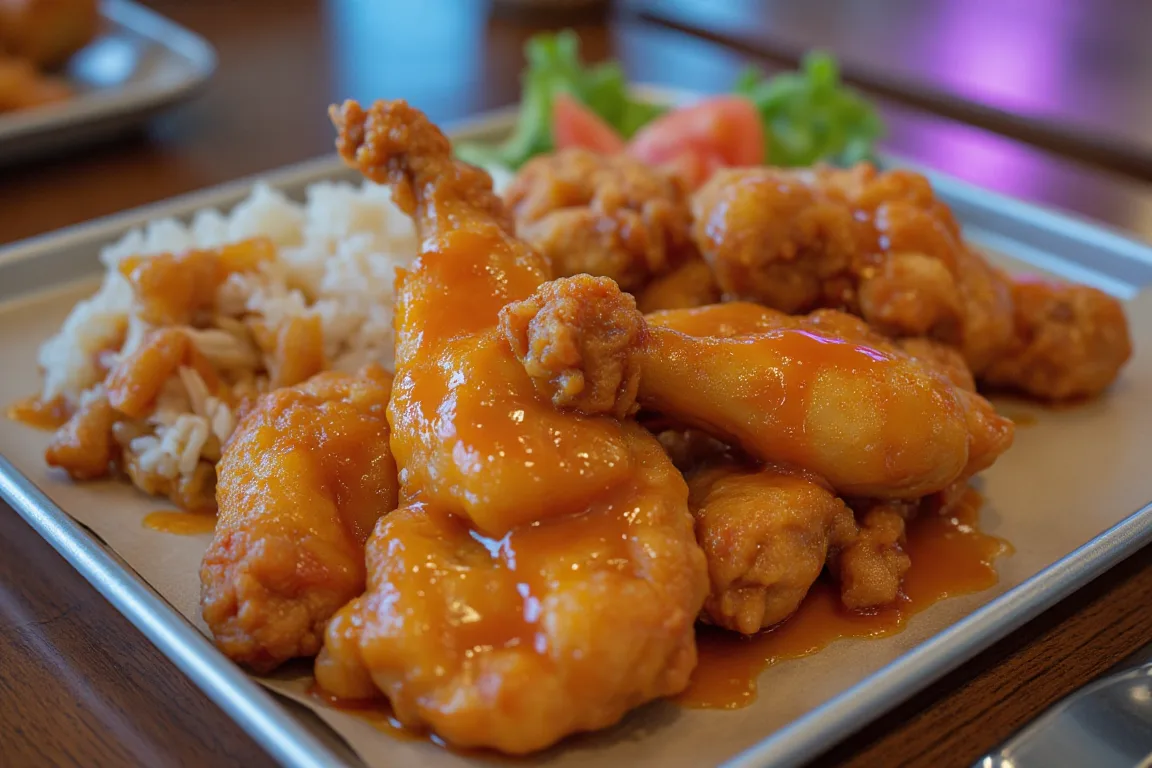Table of Contents
How Many Calories Are in School Orange Chicken? A Comprehensive Guide
Orange chicken has become a favorite dish in school cafeterias across the nation. With its sweet, tangy sauce and crispy texture, it’s hard to resist. But how does this beloved meal stack up nutritionally? How many calories are in school orange chicken, and is it a good option for a balanced diet?
In this guide, we’ll explore the calorie content and nutritional profile of school orange chicken, compare it to other meals, and provide tips for making it healthier. We’ll also answer common questions like whether it fits into a weight-loss plan and what makes it unique. Let’s dive in!
Understanding the Nutritional Profile of School Orange Chicken
What Is School Orange Chicken?
School orange chicken is a cafeteria staple inspired by Chinese-American cuisine. Typically, it features crispy fried chicken pieces coated in a sweet and savory orange-flavored sauce. While it’s often served with rice or vegetables, the star of the show is the saucy chicken itself.
Unlike restaurant versions like Panda Express, school orange chicken is usually made with a focus on cost-effectiveness and portion control. This means fewer exotic ingredients and, sometimes, a slightly lighter calorie load. However, it remains a high-calorie dish due to its fried preparation and sugary sauce.
Average Calorie Content in a Typical Serving
So, how many calories are in school orange chicken? The answer depends on portion size and recipe variations. On average, a single serving (around 3.5 oz or 100g) contains roughly 150 to 250 calories, with most calories coming from carbohydrates and fats.
Some schools provide nutrition fact sheets that show specifics. For example, one serving might contain:
- 150 calories
- 3g fat (0.5g saturated fat)
- 10g sugar
- 10g protein
These figures can vary significantly depending on the sauce’s sugar content, the amount of batter, and whether the chicken is fried or baked.
Breaking Down the Macronutrients (Protein, Fat, and Carbohydrates)
When you look closely, the calorie composition of school orange chicken is driven by its macronutrient profile:
- Protein: A serving often provides 8–12g of protein, sourced from the chicken.
- Fat: With around 3–8g of fat per serving, the frying process adds to its caloric density.
- Carbohydrates: A significant chunk of the calories (10–20g) comes from the sauce, which is loaded with sugar and cornstarch.
If paired with white rice, the total calorie count for the meal can skyrocket to 350–500 calories. That’s nearly a quarter of the recommended daily intake for children aged 6–12!
How Do School Orange Chicken Calories Compare to Other Popular Meals?
Comparison with Fast-Food Orange Chicken (e.g., Panda Express)
When comparing school orange chicken to restaurant versions like Panda Express, the differences are significant. While a typical serving of Panda Express orange chicken contains around 490 calories per 5.7 oz, school cafeteria portions are generally smaller and contain 150–250 calories per serving.
This calorie reduction is often due to portion control and ingredient adjustments, such as less sugar in the sauce or using a baked rather than fried preparation method. However, the flavor profile can be similar, making school orange chicken a decent alternative to its fast-food counterpart for those watching their calorie intake.
School Cafeteria Orange Chicken vs. Homemade Versions
Homemade orange chicken tends to be healthier than either cafeteria or restaurant options. By controlling ingredients, such as using whole chicken breast, natural sweeteners, or reducing oil, a home-cooked version may contain 100–200 calories per serving.
For example, swapping fried chicken for baked or air-fried pieces significantly cuts down on fat. Additionally, preparing a sauce with orange juice, honey, and reduced-sodium soy sauce can slash calorie and sodium content without sacrificing taste.
Calories in Other School Meals (e.g., Chicken Sandwich, Pizza)
In the cafeteria, orange chicken competes with popular options like chicken sandwiches and pizza. For comparison:
- A school chicken sandwich averages 300–400 calories, with added calories from bread and condiments.
- A slice of school pizza can range from 280 to 350 calories, depending on the topping.
Although how many calories are in school orange chicken may seem high, it’s often the lower-calorie option compared to other meals. This makes it a good choice for students aiming to maintain a balanced diet.
For more insights on balancing calories in meals, you might find this guide helpful.

Factors That Affect Calorie Content in School Orange Chicken
Ingredients and Cooking Methods
The calorie count in school orange chicken heavily depends on its preparation. Schools often use pre-breaded frozen chicken, which adds fat and carbohydrates. However, some districts are adopting healthier cooking methods like baking instead of deep-frying, which significantly reduces calories.
The sauce also plays a big role. Traditional orange chicken sauce contains sugar, corn syrup, and soy sauce, all of which add empty calories. A lighter version, with natural sweeteners or reduced sodium, can help trim the calorie count without losing flavor.
Sauce Composition and Added Sugars
Did you know the sauce is often the most calorie-dense part of orange chicken? Just a few tablespoons can pack in 50–100 calories from sugar and cornstarch alone. Schools aiming for healthier options might use lower-sugar recipes or add orange zest for flavor instead of relying on sugar.
To illustrate: a standard cafeteria recipe might include 10–15g of sugar per serving, while a healthier version could cut that down to just 5g of sugar by using substitutes like honey or agave syrup.
Portion Size Variability in School Settings
Portion size is another critical factor. While most servings are standardized, some schools may provide larger portions to accommodate older students, leading to an increase in calories. For example:
- A 3.5 oz serving contains ~150–200 calories.
- A 5 oz serving might climb to 250–300 calories, depending on the sauce.
Students and parents should be aware of these variations when estimating how many calories are in school orange chicken.
Nutritional Analysis of School Orange Chicken
Macronutrients: Carbs, Protein, and Fat
School orange chicken typically provides a mix of macronutrients, making it a reasonably balanced meal. However, the proportions can vary. On average, a serving contains:
- Carbohydrates: The breading and sweet orange sauce are significant carbohydrate sources. A single serving may contain approximately 25–30 grams of carbs, primarily from sugars and starches.
- Protein: With its chicken base, orange chicken offers about 10–15 grams of protein per serving. This can be a moderate source of protein for growing students.
- Fats: The oil used in frying contributes to the fat content. A typical portion contains 8–12 grams of fat, including both saturated and unsaturated fats.
The balance of these macronutrients means orange chicken can serve as a filling option, though the high sugar and fat levels may concern those focusing on healthy eating.
Micronutrients: Vitamins and Minerals in Orange Chicken
While orange chicken is rich in flavor, its micronutrient profile is less impressive. Some key vitamins and minerals include:
- Vitamin C: The orange sauce might contribute small amounts of vitamin C, depending on the ingredients used.
- Iron: As a chicken-based dish, it provides iron, but the content is usually modest at 5–10% of the daily recommended intake.
- Sodium: This is where orange chicken can be problematic. Many servings contain upwards of 600–800 milligrams of sodium, which is significant compared to daily intake recommendations.
For more insights into maintaining a balanced diet while enjoying flavorful meals, check out our guide on healthy lunch options.
FAQs About Orange Chicken
How Many Calories Are in School Orange Chicken?
The calorie count for school orange chicken can vary depending on preparation, but it typically ranges from 250 to 350 calories per serving. This includes the chicken, breading, and sweet orange sauce. If served with rice, the calorie count can climb to around 500–600 calories per meal.
What Is School Orange Chicken Made Of?
School orange chicken is usually made with breaded chicken pieces coated in a sweet, tangy orange sauce. Ingredients often include chicken breast, flour or cornstarch for breading, sugar, orange juice concentrate, soy sauce, and spices.
How Much Cal is a School Chicken Sandwich?
While this differs by school district, a standard school chicken sandwich can contain 350–450 calories, depending on the type of bread, condiments, and whether the chicken is grilled or breaded.
Is Orange Chicken Okay for Weight Loss?
Orange chicken can fit into a weight-loss plan in moderation. However, its high sugar and fat content make it less ideal for regular consumption. Pairing it with vegetables and choosing smaller portions can help mitigate its calorie impact.
For more delicious recipes and nutritional tips, visit our article on understanding calories in popular meals.
How to Make Informed Choices About Orange Chicken
Balancing Nutrition and Taste
When considering how many calories are in school orange chicken, it’s essential to find a balance between enjoying the meal and maintaining a healthy diet. Orange chicken often appeals to students because of its sweet, tangy flavor and crispy texture. However, making informed choices about portion size and accompanying side dishes can help reduce calorie intake.
One way to strike this balance is by choosing healthier sides, such as steamed vegetables or a fresh fruit salad, instead of calorie-heavy options like fried rice or potatoes. Additionally, schools can make subtle changes in preparation—like reducing the sugar in the sauce or baking the chicken instead of frying—to create a healthier version without sacrificing taste.
Practical Tips for Students and Parents
For students looking to enjoy orange chicken without exceeding their calorie goals, consider these tips:
- Portion Control: Ask for smaller servings of orange chicken and fill your plate with low-calorie sides.
- Stay Hydrated: Drinking water with your meal can help you feel full and avoid overeating.
- Limit Sugary Sauces: If possible, scrape off some of the sauce to reduce sugar and calorie intake.
Parents can encourage healthier eating habits by discussing the importance of balanced meals with their children and packing nutrient-dense snacks for the day.
Exploring Alternatives to Orange Chicken
Healthier School Lunch Options
If you’re wondering how many calories are in school orange chicken but are hesitant to include it in your meal plan, there are several alternatives worth considering. For example, grilled chicken or a simple turkey sandwich on whole-grain bread can be lower-calorie choices that still provide plenty of protein. Additionally, salads topped with lean protein and light dressing can be filling and nutritious without the extra calories from fried food or sugary sauces.
For More Recipe Inspiration
While orange chicken can be a tasty option, there’s a whole world of healthier recipes to explore. For students and families interested in experimenting with meals at home, dishes like baked sesame chicken or grilled teriyaki chicken offer similar flavors with fewer calories and less sugar.
For more ideas on making healthier versions of classic favorites, check out our guide on delicious recipe substitutions.

